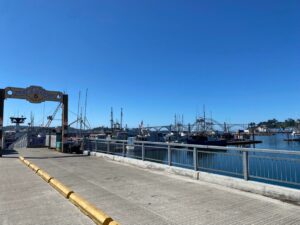
Photo credit: Sofie Carlson
Hi again, it’s Sofie Carlson, welcome back to my blog! I am in the final week of my incredible experience as the natural resources intern at Lincoln County Extension. Let me give you an update on the projects I’ve been working on this summer:
- I continued composing the monthly newsletters that my supervisor, Evie Smith, sends out: Small Farms TLC Newsletter, which provides relevant information for small farms and ranches in Tillamook, Lincoln and Clatsop counties; and LC Master Gardener’s Newsletter, which contains information and expertise to help our Master Gardeners (and any other readers) meet local challenges. In total, I helped put out six newsletters!
- I finished redesigning an updated brochure for Lincoln County Local Foods that will deliver information on all of the producers in Lincoln County conducting farm direct sales at the four local farmers markets in our county: what they sell, how to contact them and when the markets are I am really proud of the final version and can’t wait to see the printed copies make their way into the community. I joined in on one more Cooking Matters Tour at the Newport Farmers Market, with our FCH/SNAP-Ed Program Coordinator, Beatriz Botello, and Nutrition Education Program Assistant Jennifer Pettit. I hope that the brochure I created can draw more attention to Lincoln County’s farmers markets and the valuable tour that Beatriz and Jennifer give.
- I collected more blueberries and blackberries at Gibson Farms! I ended up completing seven collections at six different sites within the blueberry farm, contributing data for a larger ongoing research project that monitors a pest called spotted wing
- I did my last round of maintenance on a project called Juntos en el Jardin, which is a community garden located at the Newport This has been rewarding work and I am glad to have been involved in making the garden a more accessible space. I also joined Sea Grant marine fisheries educator Angee Doerr for four Fridays, with her Shop at the Dock program. I greeted and organized the tour groups for the guides to then teach families about Newport’s commercial fisheries through a tour of the port.
- Lastly, I attended the Kids’ Garden Fair at the Lincoln City Demonstration Garden and assisted 4-H Youth Development Program Leader Shelley Spangler with one of her summer camps. These two experiences helped solidify my love for working with
- youth and being outside learning about the natural world.

Photo credit: Sofie Carlson
As my time in Oregon comes to a close, at least for the time being, and I reflect on my summer, I want to give a huge thanks to my supervisor, Evie Smith, for her support and guidance. I have absolutely loved working with her and I could not have asked for a better role model to mentor me in this position. I would also like to thank all of the people I worked with at the Lincoln County Extension office; it was an amazing work environment, and I will miss working there! Lastly, I want to thank my aunt, Emily Blume, for telling me about this opportunity and letting me live with her and her family for the past two months in this beautiful state.
I will soon be heading back home to Vermont, where I will be starting a new job as a Naturalist Educator at North Branch Nature Center in Montpelier. I am excited to begin the next chapter of my life, teaching environmental education to youth in my home state.

















